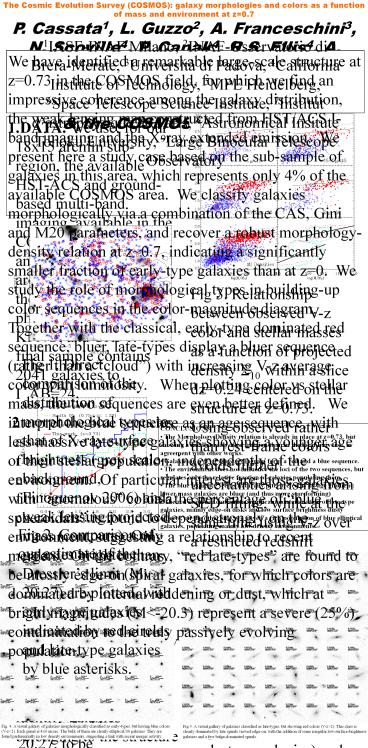Presentazione di PowerPoint - PowerPoint PPT Presentation
1 / 1
Title:
Presentazione di PowerPoint
Description:
... 6Space Telescope Science Institute, 7Institut d astrophysique de Paris, 8Astronomical Insitute Tohoku University, 9Large Binocular Telescope Observatory ... – PowerPoint PPT presentation
Number of Views:26
Avg rating:3.0/5.0
Title: Presentazione di PowerPoint
1
The Cosmic Evolution Survey (COSMOS) galaxy
morphologies and colors as a function of mass and
environment at z0.7 P. Cassata1, L. Guzzo2, A.
Franceschini3, N. Scoville4, P. Capak4, R.S.
Ellis4, A. Finoguenov5, A. Koekemoer6, R.
Massey4, H.J. McCracken7, B. Mobasher6, Y.
Taniguchi8, D.J. Thompson9 the COSMOS
collaboration
1IASF-INAF Milano, 2INAF-Osservatorio di
Brera-Merate, 3Università di Padova, 4California
Institute of Technology, 5MPE Heidelberg, 6Space
Telescope Science Institute, 7Institut
dastrophysique de Paris, 8Astronomical Insitute
Tohoku University, 9Large Binocular Telescope
Observatory
We have identified a remarkable large-scale
structure at z0.73 in the COSMOS field, for
which we find an impressive coherence among the
galaxy distribution, the weak lensing map
constructed from HST/ACS I-band imaging and the
X-ray extended emission. We present here a study
case based on the sub-sample of galaxies in this
area, which represents only 4 of the available
COSMOS area. We classify galaxies
morphologically via a combination of the CAS,
Gini and M20 parameters, and recover a robust
morphology-density relation at z0.7, indicating
a significantly smaller fraction of early-type
galaxies than at z0. We study the role of
morphological types in building-up color
sequences in the color-magnitude diagram.
Together with the classical, early-type dominated
red sequence, bluer, late-types display a bluer
sequence (rather than a cloud) with increasing
V-z average color with luminosity. When
plotting color vs stellar mass, the two sequences
are even better defined. We interpret the blue
sequence as an age sequence, with less massive
late-type galaxies showing a younger age of their
stellar population, independently of the
environment. Of particular interest are those
galaxies with anomalous colors the percentage
of blue spheroidals is found to depend strongly
on the environment, suggesting a relationship to
recent mergers. On the contrary, red
late-types are found to be mostly edge-on spiral
galaxies, for which colors are dominated by
internal reddening or dust, which at bright
magnitudes (Mlt-20.3) represent a severe (25)
contamination to the truly passively evolving
population.
- DATA. We use, for our 18x15 arcmin sub-region,
the available HST-ACS and ground-based multi-band
imaging available in the COSMOS area. Masses and
photometric redshift are calculated by fitting
the U,B,V,g,r,i,z and K photometry from Subaru,
KPNO, and CHFT. The final sample contains 2041
galaxies to I_AB24. - 2. ANALYSIS. Galaxies are classified
morphologically into early- and late- types from
the ACS data, via a combination of concentration,
asymmetry, clumpiness, Gini and M20 parameters. - Local density is estimated for each galaxy
according to Dressler ?10 definition, using
photometric redshifts to identify galaxies
belonging to the structure and its surroundings.
We use three different redshift slices (?z0.06,
0.12, 0.18) to test the robustness of the
approach and correct our density estimates for
the effect of back- and foreground contamination.
- CONCLUSIONS
- The Morphology-Density relation is already in
place at z0.73, but showing a smaller early-type
fraction than in the local Universe, in agreement
with other works. - Galaxies in a (V-z) vs mass diagram form a red
and a blue sequence. - The environment does not influence the loci of
the two sequences, but regulates only the
relative fraction of galaxies populating them. - The blue sequence seems naturally interpreted as
an age gradient lower mass galaxies are bluer
(and thus more star-forming) - The red sequence contains a significant
contamination of late-type galaxies, mainly
edge-on disks and low surface brightness dusty
objects on the other side, we unveil a rich
population of blue elliptical galaxies,
populating mainly low density environments.

